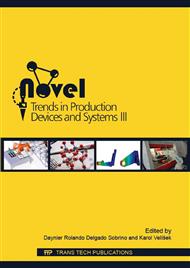[1]
Krzyżak, A., Drabik, M., Zyśko, Ł. and Dulebová, L. Selected Properties and Shrinkage Compensating Effect by Injection Moulding of Origin and Recycled Thermoplastic Composites with Polypropylene (PP) Matrix, Talcum and Glass Fiber, Advanced Materials Research, vol. 1001, pp.187-193. Trans Tech Publications, (2014).
DOI: 10.4028/www.scientific.net/amr.1001.187
Google Scholar
[2]
Dulebová, L., Spišák, E., Duleba, B., Greškovič, F., Garbacz, T., Characterization of Mechanical and Thermal Properties of PP/Mineral Composites, Advanced Materials Research, vol. 1025, pp.241-245. Trans Tech Publications, (2014).
DOI: 10.4028/www.scientific.net/amr.1025-1026.241
Google Scholar
[3]
Běhálek, L., Lenfeld, P., Habr, J., Dobránsky, J., Seidl, M., Bobek, J., Physical-mechanical properties of hollow glass microspheres filled polypropylene composites for injection moulding, Key Engineering Materials, Vol. 669, pp.3-10, (2016).
DOI: 10.4028/www.scientific.net/kem.669.3
Google Scholar
[4]
B. Kratochvíl, V. Švorčík, D. Vojtěch, Introduction to the study of materials (Úvod do studia materiálů, ). First ed., Praha, VSCHT, (2005).
Google Scholar
[5]
Wambua, P., Ivens, J. and Verpoest, I., Natural fibres: can they replace glass in fibre reinforced plastics?, Composites science and technology, vol. 63, pp.1259-1264, (2003).
DOI: 10.1016/s0266-3538(03)00096-4
Google Scholar
[6]
J. Chaichanawong et al., Effect of moisture on the mechanical properties of glass fiber reinforced polyamide composites, Advanced Powder Technology (2016).
DOI: 10.1016/j.apt.2016.02.006
Google Scholar
[7]
Ferreno, D., Carrascal, I., Ruiz, E. and Casado, J.A., Characterisation by means of a finite element model of the influence of moisture content on the mechanical and fracture properties of the polyamide 6 reinforced with short glass fibre, Polymer Testing, vol. 30, no. 4, pp.420-428, (2011).
DOI: 10.1016/j.polymertesting.2011.03.001
Google Scholar
[8]
Senthilvelan, S. and Gnanamoorthy, R., Damping characteristics of unreinforced, glass and carbon fiber reinforced nylon 6/6 spur gears. Polymer testing, vol. 25, no. 4, pp.56-62. (2006).
DOI: 10.1016/j.polymertesting.2005.09.005
Google Scholar
[9]
Teixeira, D., M. Giovanela, L. B. Gonella, and J. S. Crespo, Influence of injection molding on the flexural strength and surface quality of long glass fiber-reinforced polyamide 6. 6 composites, Materials & Design, vol. 85, pp.695-706, (2015).
DOI: 10.1016/j.matdes.2015.07.097
Google Scholar
[10]
Mallarino, S., Chailan, J.F. and Vernet, J.L., Glass fibre sizing effect on dynamic mechanical properties of cyanate ester composites I. Single frequency investigations. European Polymer Journal, vol. 41 (8), pp.1804-1811, (2005).
DOI: 10.1016/j.eurpolymj.2005.02.022
Google Scholar


